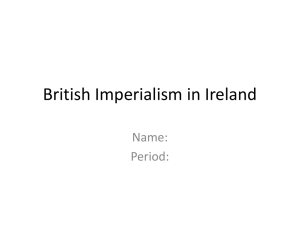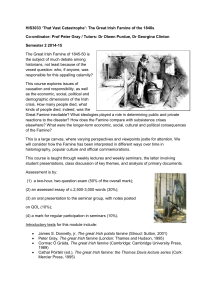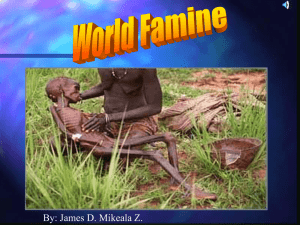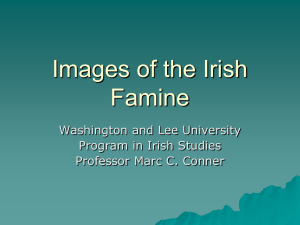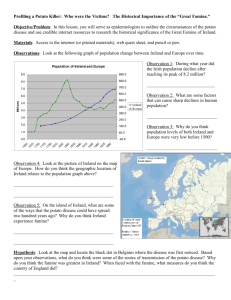Ireland's Great Famine - Economic History Society
advertisement
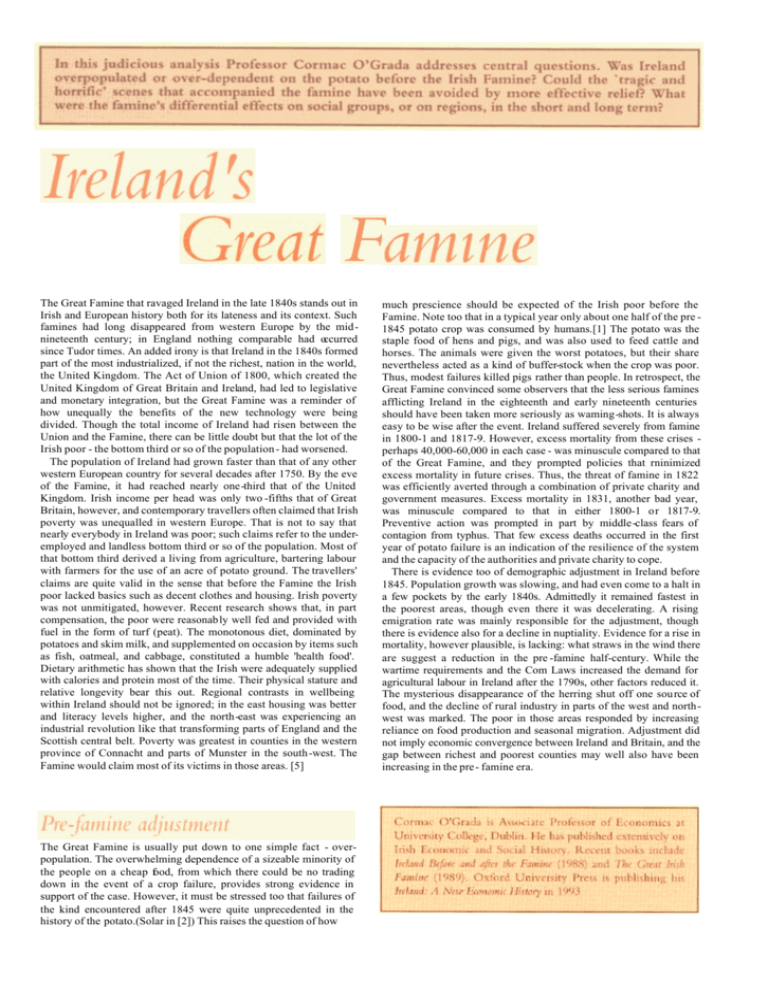
The Great Famine that ravaged Ireland in the late 1840s stands out in Irish and European history both for its lateness and its context. Such famines had long disappeared from western Europe by the midnineteenth century; in England nothing comparable had occurred since Tudor times. An added irony is that Ireland in the 1840s formed part of the most industrialized, if not the richest, nation in the world, the United Kingdom. The Act of Union of 1800, which created the United Kingdom of Great Britain and Ireland, had led to legislative and monetary integration, but the Great Famine was a reminder of how unequally the benefits of the new technology were being divided. Though the total income of Ireland had risen between the Union and the Famine, there can be little doubt but that the lot of the Irish poor - the bottom third or so of the population - had worsened. The population of Ireland had grown faster than that of any other western European country for several decades after 1750. By the eve of the Famine, it had reached nearly one-third that of the United Kingdom. Irish income per head was only two -fifths that of Great Britain, however, and contemporary travellers often claimed that Irish poverty was unequalled in western Europe. That is not to say that nearly everybody in Ireland was poor; such claims refer to the underemployed and landless bottom third or so of the population. Most of that bottom third derived a living from agriculture, bartering labour with farmers for the use of an acre of potato ground. The travellers' claims are quite valid in the sense that before the Famine the Irish poor lacked basics such as decent clothes and housing. Irish poverty was not unmitigated, however. Recent research shows that, in part compensation, the poor were reasonably well fed and provided with fuel in the form of turf (peat). The monotonous diet, dominated by potatoes and skim milk, and supplemented on occasion by items such as fish, oatmeal, and cabbage, constituted a humble 'health food'. Dietary arithmetic has shown that the Irish were adequately supplied with calories and protein most of the time. Their physical stature and relative longevity bear this out. Regional contrasts in wellbeing within Ireland should not be ignored; in the east housing was better and literacy levels higher, and the north-east was experiencing an industrial revolution like that transforming parts of England and the Scottish central belt. Poverty was greatest in counties in the western province of Connacht and parts of Munster in the south-west. The Famine would claim most of its victims in those areas. [5] The Great Famine is usually put down to one simple fact - overpopulation. The overwhelming dependence of a sizeable minority of the people on a cheap food, from which there could be no trading down in the event of a crop failure, provides strong evidence in support of the case. However, it must be stressed too that failures of the kind encountered after 1845 were quite unprecedented in the history of the potato.(Solar in [2]) This raises the question of how much prescience should be expected of the Irish poor before the Famine. Note too that in a typical year only about one half of the pre 1845 potato crop was consumed by humans.[1] The potato was the staple food of hens and pigs, and was also used to feed cattle and horses. The animals were given the worst potatoes, but their share nevertheless acted as a kind of buffer-stock when the crop was poor. Thus, modest failures killed pigs rather than people. In retrospect, the Great Famine convinced some observers that the less serious famines afflicting Ireland in the eighteenth and early nineteenth centuries should have been taken more seriously as waming-shots. It is always easy to be wise after the event. Ireland suffered severely from famine in 1800-1 and 1817-9. However, excess mortality from these crises perhaps 40,000-60,000 in each case - was minuscule compared to that of the Great Famine, and they prompted policies that rninimized excess mortality in future crises. Thus, the threat of famine in 1822 was efficiently averted through a combination of private charity and government measures. Excess mortality in 1831, another bad year, was minuscule compared to that in either 1800-1 or 1817-9. Preventive action was prompted in part by middle-class fears of contagion from typhus. That few excess deaths occurred in the first year of potato failure is an indication of the resilience of the system and the capacity of the authorities and private charity to cope. There is evidence too of demographic adjustment in Ireland before 1845. Population growth was slowing, and had even come to a halt in a few pockets by the early 1840s. Admittedly it remained fastest in the poorest areas, though even there it was decelerating. A rising emigration rate was mainly responsible for the adjustment, though there is evidence also for a decline in nuptiality. Evidence for a rise in mortality, however plausible, is lacking: what straws in the wind there are suggest a reduction in the pre -famine half-century. While the wartime requirements and the Com Laws increased the demand for agricultural labour in Ireland after the 1790s, other factors reduced it. The mysterious disappearance of the herring shut off one source of food, and the decline of rural industry in parts of the west and northwest was marked. The poor in those areas responded by increasing reliance on food production and seasonal migration. Adjustment did not imply economic convergence between Ireland and Britain, and the gap between richest and poorest counties may well also have been increasing in the pre- famine era. counties. The blight baffled contemporary scientific expertise. One expert correctly diagnosed the mold on diseased potato tubers as a 'vampire' fungus, but most influential botanists declared it a kind of dry rot. However, since no cure for such fungi would be forthcoming until the 1880s, inaccurate diagnosis did not count for much. In the following year (1846) the blight's conquest was almost complete, and the real beginnings of the Famine date from autumn of that year. By late 1846 famine conditions were widespread. Nature played a cruel trick on people's expectations in 1847. Because of the scarcity of seed and the negative signals given by the failures of 1845 and 1846, the acreage planted in 1847 was small. Yields per acre turned out to be generous, however. That encouraged people to revert to planting a bigger acreage in 1848, but that year's crop also failed disastrously. In effect, therefore, the Famine was the product of four years of poor potato harvests. Thus food shortages rather than entitlement shifts were the main cause of famine. Moreover, while Ireland continued to export grain during the crisis, the trade in grain was a two -way one, and the overall balance was markedly negative in the late 1840s. [1] Famine and its relief Deaths began to mount in late 1846, and graphic accounts of the crisis soon reached London papers such as The Illustrated London News and The Times.[8] By spring 1847 the The potato The dominance of the potato in Ireland on the eve of the Famine was unequalled anywhere else.[I] For the landless and semi-landless poor, consumption per adult male reached twelve pounds daily throughout most of the year. Consumption declined with income, but Irish people of all classes liked their potatoes. Introduced first in the southwest of Ireland, probably in the early seventeenth century, the potato had made its first successful inroads there. Diffusion was a gradual process; it was still proceeding in parts of the east and north in the late eighteenth century. The early history of the potato in Ireland is a mystery, and the potato's transformation from a seasonal garden crop in the early seventeenth century to a staple by the late eighteenth century is still not fully understood. Over time, the number of varieties sown increased. In the late eighteenth century the popularity of a variety called the Apple, a late variety not fit to eat before Christmas, meant that potatoes were available nearly all year. The most notorious variety was the Lumper, introduced from Scotland around 1810. A frequently-noted attribute of the watery and bland-tasting Lumper was its ability to produce a generous crop in poor soil. For this reason it was widely adopted by the poor. Because it failed disastrously during the Famine, it earned a doubly poor reputation. It is ironic, then, that part of the reason for its original diffusion was its resistance to pests. The potato blight (phytophthera infestans) was first noted in Ireland on 6 September 1845, having made its way westward from Belgium through England. The disease caused the potato crop to rot in the ground and omit an unpleasant stench. This first onslaught of the blight turned out to be most serious in the east of Ireland, and certain pockets in extreme west seem to have escaped v irtually scot-free in the first year. A special crop return by the constabulary implies an overall shortfall of somewhat less than one-half in 1845/6. The rise in potato prices was greatest in certain eastern O’Grada, Refresh 15 (Autumn 1992) price of potatoes had reached four times their pre-blight norm. Grain prices rose too, though less dramatically. Deaths became commonplace. As is generally the case with famine, literal starvation claimed relatively few deaths, dysentery and typhoid fever being the main killers. The incidence of dietary -deficiency diseases such as scurvy, previously uncommon in Ireland, also rose. (Crawford [2]) Tragic and horrific scenes ensued all over the island; mass graves, corpses gnawed by rats, hunger marches, roadside deaths, the dying left unassisted for fear of contagion. Crimes against property rocketed, and were severely dealt with. Some landed proprietors acquitted themselves well, committing time and money to relief. Others evicted without compunction. It must be said that the difficulties facing landlords, on whom the main burden of relief charges fell, were real. Nevertheless, the eviction statistics in the wake of the Famine make for shocking reading: the official count is well over two hundred thousand people between 1849 and 1854, and that excluded those who voluntarily surrendered possession in exchange for a relief entitlement or subsidized emigration.[3] Like pre -famine poverty the famine had an important regional dimension. Mapping the proportion of the population on food rations at the height of the crisis by poor-law union produces a striking pattern. East of a line linking Wexford and Sligo the proportion on relief rarely exceeded one-third. To the west of that line recourse to the soup kitchen was much greater, exceeding four-fifths in much of Mayo and Galway. It was hoped that the high prices would encourage Irish merchants to purchase and mill foreign grain. That happened eventually; by summer 1847, prices had fallen back considerably. The first attack of phytophthera infestans occurred while Sir Robert Peel was prime minister. Peel had personal experience of dealing with famine in Ireland, and took forceful measures to prevent excess mortality in 1845/6. These included public works and the repeal of the Corn Laws, which entailed the virtual freeing of the six trade in grain. Repeal of the Corn Laws caused Peel's Tories to split and forced his resignation, and he was succeeded by Lord John Russell. The attitude of Russell's Whig administration to Ireland's problems was more doctrinaire than its predecessor's. It is also true that the challenge facing the Whigs was far more serious. Substantial loss of life in 1846-7 was probably unavoidable under either Tories or Whigs. Nevertheless, there are instances of counter-productive measures, and the Treasury was undoubtedly mean-minded. By and large, the Whigs were obsessive about letting public funds allow Irish landlords to shirk their responsibilities to the poor, and about crowding out private charity. They also worried about the moral hazard implications of relief, i.e. the danger that in relieving the Irish they would only be paving the way for an even more serious crisis in the future. (O'Neill [4]) Their attitudes were supported by Charles Trevelyan, doctrinaire permanent under-secretary at the Treasury. Peel relied on providing employment through public works. The Whigs stuck with this policy for a time, and numbers on the works increased greatly in late 1846 and early 1847. However, it was soon realized that task work was not geared to helping those most in need; employers and relief officials feared that public works were competing with 'real' work; and, inevitably, there was a good deal of corruption. These considerations dictated a switch to direct food aid in late spring 1847. At a maximum over three million soup rations were being doled out daily, even in the remotest regions. The soup, in effect a maizebased gruel or 'slop', failed to sustain many of those already weakened by malnutrition. Still, deaths took a turn downward in the summer of 1847. In August 1847 Whitehall declared the crisis over, and the burden of future relief shifted to the Irish Poor Law. While the tide had turned in most areas, mortality continued to be very high in the west in 1848 and 1849. Death and migration The death toll cannot be measured with precision, but dispassionate estimates suggest that about one million died as a direct result of the crisis. [5] The poor were the main casualties, though others who came into contact with the poor in the course of their work, such as medical practitioners and the cle rgy, also perished in numbers. Children and old people were most likely to succumb, but that was so in normal times too. Indeed, famine mortality seems to have mirrored normal mortality by age and sex. An important feature of mortality was its long-drawn out character; excess mortality was still significant four or five years after the first attack of blight. Mass emigration was also a central feature of the `Famine years. Between the mid-1840s and mid-1850s nearly two million people left Ireland for good. Most headed for the United States, but Great Britain and Canada were also important destinations. By 1851 the United States contained nearly one million Irish-born people, O’Grada, Refresh 15 (Autumn 1992) Britain over 0.7 million, and Canada over 0.2 million. However, the entire outflow of the late 1840s must not be attributed to the Famine, because long-distance migration from Ireland had already been established by 1845. Assisted emigration was a much more important feature during the Famine than before, though most migrants still travelled without state or landlord assistance. This probably meant that a poverty trap prevented many of the very poor from leaving, and that the emigrants were disproportionately from small-farm rather than labouring backgrounds. A corollary is that among famine casualities, the poor tended to die, and the not-so-poor to emigrate. Nevertheless, emigration from Ireland during the Famine differed markedly from earlier outflows in that the poorest counties now supplied more than their proportionate share of emigrants. At the outset, an unregulated market in passenger traffic across the Atlantic led to the exploitation of desperate and ignorant seven emigrants, and mortality on the Atlantic passage was very high in 1847. However, after several scandals and disasters, legislation to control the traffic in passengers led to improvements in subsequent years. (MacDonagh in [4]) Several historians have answered this counterfactual in the affirmative. In support of this, the experience of other European countries quite unaffected by the blight suggests that emigration from Ireland after mid century would have been high anyway. Moreover, the changes in agriculture were in large part induced by world market A Famine Funeral. 'Coffins are unprocurable'. Illustrated London News, 1847. trends. Besides, we have seen that demographic The most obvious losers adjustment of a kind was under way even before 1846. However, the from the Great Famine were the million or so who perished. Yet the faminemattered'; the changes in the agricultural labour force and Famine adversely affected people across the whole socioeconomic output cannot be accounted for by relative price shifts alone. After all, scale. Landlords found their rent receipts down, and their poor rate the decline in potato yields was famine-induced, and that alone was bills up. Farmers may have benefited from the rent reductions, but the bound to force a shift to pasture.[71 Taking a longer perspective, the wage they were required to pay to maintain a labour force capable of reduction in the labour force suggests a redistribution of income from working rose. Among farmers, only those specializing in grazing are land to labour. Landlords were saved from such a shift for some likely to have benefited from the price shifts caused by the Famine. decades by the drift towards pasture and dairying. Though it led to Lawyers, waxing fat on the massive number of property transfers higher living standards, the Famine also seems to have traumatized occasioned by the tragedy, are another group who benefited in the those who survived it. Memories of the Famine and the relentless short run; their numbers rose between 1841 and 1851. In the longer outflow of people took much of the fun out of social life in postrun, fewer people meant less pressure on the land and higher wages famine Ireland, which is depicted in most accounts as a sober and for those who survived. rather cheerless place. Losers and gainers Aftermath The population of Ireland continued to decline after the Famine, and by 1900 had nearly halved. The decline was largely restricted to rural areas. The net result was that though the population of most Irish towns did not grow much, Ireland was a good deal more urbanized in 1900 than in 1850. At first it may have seemed as if the vacuum created in some western areas severely thinned by the Famine would be filled again. In such areas people continued to marry young, farms continued to be subdivided, and the potato continued to play a leading role in the diet. Some isolated parishes even experienced population growth in the 1850s and 1860s. Overall, however, between the Famine and the First World War decline was greatest in the west. Emigration was largely responsible for the decline; over four million people left for good between the early 1850s and 1914. A reduction in nuptiality also reduced the rate of natural increase. Living standards rose. Real wages jumped in the wake of the Famine, but the rise persisted, and real wages in 1900 were more than double their level half a century earlier. Rising labour costs and relative price shifts caused agricultural out- put to shift towards livestock. The quality of housing improved, and diet became more varied. AU these developments followed in the wake of the Famine. Would they have occurred in any case? References [1] A. Bourke, The Visitation of God? 7he Potato and the Great Irish Famine (1992). [2] E.M. Crawford, Famine: 7he Irish Experience (1989). [3] J.S. DonneHy, 'The Famine', in W.E. Vaughan, ed., T'he New History of Ireland vol. 5 (1989), Chapters 12 to 19. [4] R.D. Edwards and T.D. Williams, eds., The Great Famine: Studies in Irish History (1956,1993). [5] J. Mokyr, Why Ireland Starved: A Quantitative and Analytical History of the Irish Economy 1800-1845, 2nd ed., (1985). [6] C.O'Grada, 7he Great Irish Famine (1989). [7] K. O'Rourke, 'Did the Great Famine Matter?', Journal of Economic History, vol. 51 (1991). [8] C. Woodham-Smith, The Great Hunger (1990) eight O’Grada, Refresh 15 (Autumn 1992)

